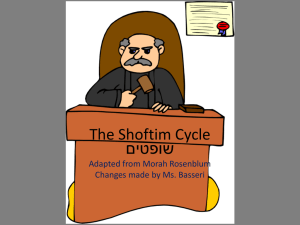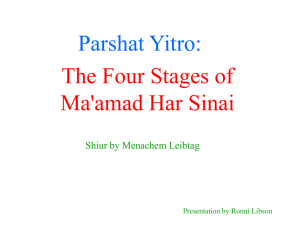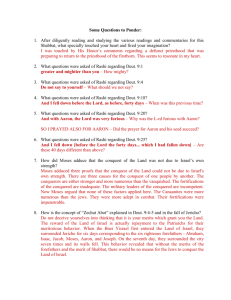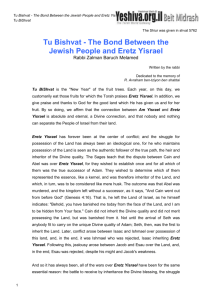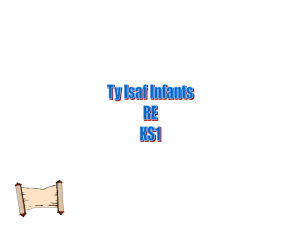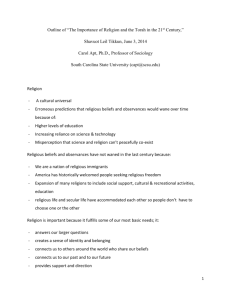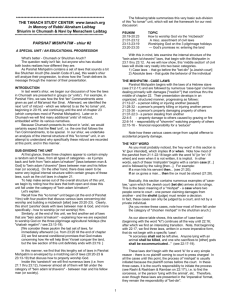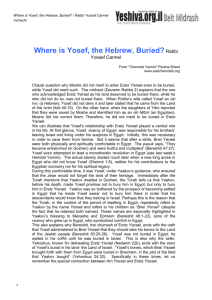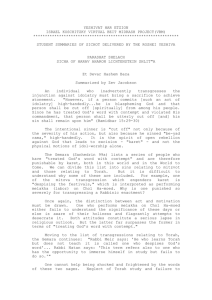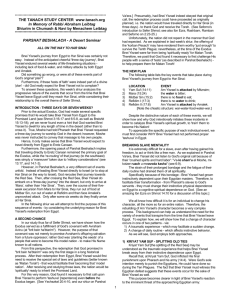Word - Tanach Study Center
advertisement
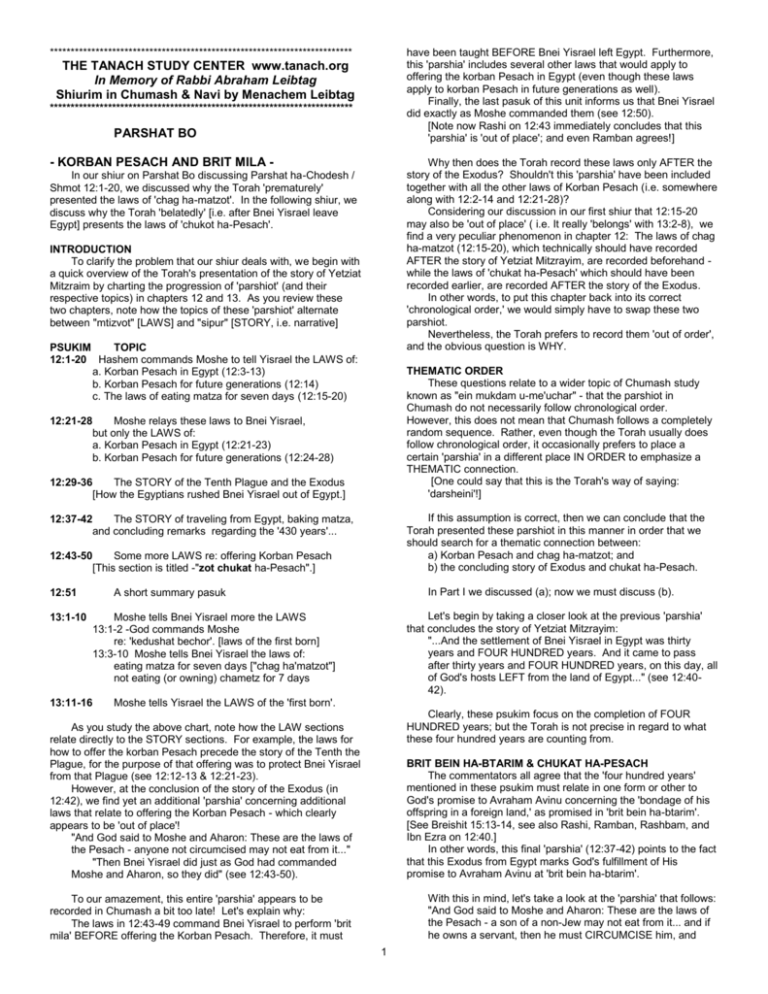
************************************************************************* have been taught BEFORE Bnei Yisrael left Egypt. Furthermore, this 'parshia' includes several other laws that would apply to offering the korban Pesach in Egypt (even though these laws apply to korban Pesach in future generations as well). Finally, the last pasuk of this unit informs us that Bnei Yisrael did exactly as Moshe commanded them (see 12:50). [Note now Rashi on 12:43 immediately concludes that this 'parshia' is 'out of place'; and even Ramban agrees!] THE TANACH STUDY CENTER www.tanach.org In Memory of Rabbi Abraham Leibtag Shiurim in Chumash & Navi by Menachem Leibtag ************************************************************************* PARSHAT BO - KORBAN PESACH AND BRIT MILA - Why then does the Torah record these laws only AFTER the story of the Exodus? Shouldn't this 'parshia' have been included together with all the other laws of Korban Pesach (i.e. somewhere along with 12:2-14 and 12:21-28)? Considering our discussion in our first shiur that 12:15-20 may also be 'out of place' ( i.e. It really 'belongs' with 13:2-8), we find a very peculiar phenomenon in chapter 12: The laws of chag ha-matzot (12:15-20), which technically should have recorded AFTER the story of Yetziat Mitzrayim, are recorded beforehand while the laws of 'chukat ha-Pesach' which should have been recorded earlier, are recorded AFTER the story of the Exodus. In other words, to put this chapter back into its correct 'chronological order,' we would simply have to swap these two parshiot. Nevertheless, the Torah prefers to record them 'out of order', and the obvious question is WHY. In our shiur on Parshat Bo discussing Parshat ha-Chodesh / Shmot 12:1-20, we discussed why the Torah 'prematurely' presented the laws of 'chag ha-matzot'. In the following shiur, we discuss why the Torah 'belatedly' [i.e. after Bnei Yisrael leave Egypt] presents the laws of 'chukot ha-Pesach'. INTRODUCTION To clarify the problem that our shiur deals with, we begin with a quick overview of the Torah's presentation of the story of Yetziat Mitzraim by charting the progression of 'parshiot' (and their respective topics) in chapters 12 and 13. As you review these two chapters, note how the topics of these 'parshiot' alternate between "mtizvot" [LAWS] and "sipur" [STORY, i.e. narrative] PSUKIM TOPIC 12:1-20 Hashem commands Moshe to tell Yisrael the LAWS of: a. Korban Pesach in Egypt (12:3-13) b. Korban Pesach for future generations (12:14) c. The laws of eating matza for seven days (12:15-20) THEMATIC ORDER These questions relate to a wider topic of Chumash study known as "ein mukdam u-me'uchar" - that the parshiot in Chumash do not necessarily follow chronological order. However, this does not mean that Chumash follows a completely random sequence. Rather, even though the Torah usually does follow chronological order, it occasionally prefers to place a certain 'parshia' in a different place IN ORDER to emphasize a THEMATIC connection. [One could say that this is the Torah's way of saying: 'darsheini'!] 12:21-28 Moshe relays these laws to Bnei Yisrael, but only the LAWS of: a. Korban Pesach in Egypt (12:21-23) b. Korban Pesach for future generations (12:24-28) 12:29-36 The STORY of the Tenth Plague and the Exodus [How the Egyptians rushed Bnei Yisrael out of Egypt.] If this assumption is correct, then we can conclude that the Torah presented these parshiot in this manner in order that we should search for a thematic connection between: a) Korban Pesach and chag ha-matzot; and b) the concluding story of Exodus and chukat ha-Pesach. 12:37-42 The STORY of traveling from Egypt, baking matza, and concluding remarks regarding the '430 years'... 12:43-50 Some more LAWS re: offering Korban Pesach [This section is titled -"zot chukat ha-Pesach".] 12:51 13:1-10 In Part I we discussed (a); now we must discuss (b). A short summary pasuk Let's begin by taking a closer look at the previous 'parshia' that concludes the story of Yetziat Mitzrayim: "...And the settlement of Bnei Yisrael in Egypt was thirty years and FOUR HUNDRED years. And it came to pass after thirty years and FOUR HUNDRED years, on this day, all of God's hosts LEFT from the land of Egypt..." (see 12:4042). Moshe tells Bnei Yisrael more the LAWS 13:1-2 -God commands Moshe re: 'kedushat bechor'. [laws of the first born] 13:3-10 Moshe tells Bnei Yisrael the laws of: eating matza for seven days ["chag ha'matzot"] not eating (or owning) chametz for 7 days 13:11-16 Moshe tells Yisrael the LAWS of the 'first born'. Clearly, these psukim focus on the completion of FOUR HUNDRED years; but the Torah is not precise in regard to what these four hundred years are counting from. As you study the above chart, note how the LAW sections relate directly to the STORY sections. For example, the laws for how to offer the korban Pesach precede the story of the Tenth the Plague, for the purpose of that offering was to protect Bnei Yisrael from that Plague (see 12:12-13 & 12:21-23). However, at the conclusion of the story of the Exodus (in 12:42), we find yet an additional 'parshia' concerning additional laws that relate to offering the Korban Pesach - which clearly appears to be 'out of place'! "And God said to Moshe and Aharon: These are the laws of the Pesach - anyone not circumcised may not eat from it..." "Then Bnei Yisrael did just as God had commanded Moshe and Aharon, so they did" (see 12:43-50). BRIT BEIN HA-BTARIM & CHUKAT HA-PESACH The commentators all agree that the 'four hundred years' mentioned in these psukim must relate in one form or other to God's promise to Avraham Avinu concerning the 'bondage of his offspring in a foreign land,' as promised in 'brit bein ha-btarim'. [See Breishit 15:13-14, see also Rashi, Ramban, Rashbam, and Ibn Ezra on 12:40.] In other words, this final 'parshia' (12:37-42) points to the fact that this Exodus from Egypt marks God's fulfillment of His promise to Avraham Avinu at 'brit bein ha-btarim'. With this in mind, let's take a look at the 'parshia' that follows: "And God said to Moshe and Aharon: These are the laws of the Pesach - a son of a non-Jew may not eat from it... and if he owns a servant, then he must CIRCUMCISE him, and To our amazement, this entire 'parshia' appears to be recorded in Chumash a bit too late! Let's explain why: The laws in 12:43-49 command Bnei Yisrael to perform 'brit mila' BEFORE offering the Korban Pesach. Therefore, it must 1 then he may eat it... and if a stranger lives with you and wants to offer a korban Pesach, first he must be CIRCUMCISED... and anyone NOT CIRCUMCISED may not eat from it." (see 12:43-48). of yetziat Mitzrayim, the Torah then returns to complete the transmission of the laws relevant to the korban pesach. Rav Eliyahu Mizrachi, in his work on Rashi's commentary, explains along similar lines. Note how the primary focus of these mitzvot in 'chukat haPesach' is the requirement to perform BRIT MILA before offering the Korban Pesach (note 12:43,44,48). But as we noted above, the final psukim of the preceding story relate back to the theme of BRIT BEIN HA-BTARIM! Therefore, this juxtaposition may point once again to thematic connection between these two central covenants of Sefer Breishit. [See last week's shiur on Parshat Va'era.] 3) A much different explanation is given by the Abarbanel and, later, by Rav Shimshon Refael Hirsch. They claim that this section, which deals primarily with the procedure required before a foreigner or a convert may partake of the korban Pesach, is directed towards the 'erev rav', about whom the Torah speaks just several verses earlier. (In their respective commentaries, both the Abarbanel and Rav Hirsch go through all the halachot mentioned in this section and explain how they all address the unique circumstance of the erev rav.) In this manner, Chumash may be alluding to an important thematic message: If we consider Korban Pesach as the manner by which we thank God for His fulfillment of Brit bein Ha-btarim, then before doing so, we must first remind ourselves of our commitment to His covenant of 'brit MILA'. [Recall how Brit Mila reflects the special relationship [or partnership] between God and Bnei Yisrael (to accept Him as our God - "lihiyot lachem l-Elokim" / see Breishit 17:7-8). ] B. The Four Hundred and Thirty Years of Bondage As we noted, the Torah says in 12:40 that Bnei Yisrael spent 430 years in Egypt. Rashi there notes that based on the genealogical record of Yaakov's family when he relocated in Egypt (in Parshat Vayigash - Breishit 46:8-27) as well as that in Parshat Va'era (Shmot 6:14-25), this is a mathematical impossibility. (In short, Kehat, Moshe's grandfather, is included among those who moved with Yaakov to Egypt; four hundred years could not have passed from Kehat's move to Egypt until his grandson, Moshe, led the slaves to freedom at the age of eighty.) Further confounding the issue is the fact that Hashem had informed Avraham of a 400-year period of bondage, not 430 years. For this reason, most sources among Chazal and the mefarshim claim - as mentioned in the shiur - that the period in question began with the birth of Yitzchak. Hashem had promised that Avraham's offspring would be "foreigners in a land not their own" (Breishit 15:13). This period began when his heir, Yitzchak, was born in a country where he was deemed a foreigner. Why Yitzchak - and, after him, Yaakov and his children - held foreigner status in Canaan is not entirely clear. Ibn Ezra (commenting on our pasuk) cites a theory that during this period Canaan was subject to Egyptian rule. Although the Ibn Ezra claims that there is no source to substantiate such a theory, Rav Menachem Kasher (Torah Shleima on our pasuk, footnote 601) indeed brings several sources to this effect. The Maharal, by contrast, in his commentary, "Gur Aryeh" on our pasuk, posits a different explanation for this foreigner status. As Hashem had decreed that Avraham's offspring would come under subjugation in a foreign land, their residence in Canaan before their descent to Egypt was not permanent. As such, they could not be considered anything more than foreigners. Rashi, in his commentary to Breishit 15:13, cites psukim that imply that Yitzchak and Yaakov's residence in Canaan was indeed that of foreigners. In any event, the sixty years of Yitzchak's life before Yaakov's birth (Breishit 25:26) and Yaakov's one hundred and thirty years before moving to Egypt (Breishit 47:8) combine to comprise 190 of the 400 years of exile. This leaves 210 years, the commonly accepted duration of the Egyptian exile (see Breishit Rabba 91:2). This theory, that the period of 'exile' began with the birth of Yitzchak, dates back as early as the Septuagint, which adds onto our pasuk the words, 'u-bish'ar aratzot', meaning, that the 430 years mark the period in which Bnei Yisrael were foreigners in Egypt as well as in other lands. Hence, this intentional juxtaposition may emphasize how one must first confirm his commitment at a personal and family level as reflected in Brit Mila, before he can proclaim his affiliation at the national level, as reflected in the offering of the korban Pesach - to thank God for His fulfillment of brit bein ha-btarim. This critical balance between one's commitment to God at both the personal and national level will emerge as a primary theme in Chumash, especially in our study of Sefer Shmot and Sefer Devarim. Iy"h, we will return to this topic in the shiurim that follow; Till then, shabbat shalom, menachem =============== FOR FURTHER IYUN: A. The Position of 'Zot Chukat Ha-Pesach' Three answers as to why this section is transplanted from its chronological location appear in the following commentators: 1) Ibn Ezra, Seforno and Chizkuni claim that the laws of "chukat ha'pesach" apply only to future generations, and hence this entire section is not out of chronological sequence. The Mechilta (on 12:43) quotes a debate between Rabbi Yoshia and Rabbi Yonatan as to whether these psukim refer only to Pesach Mitzrayim or to Pesach dorot, as well. The Ibn Ezra disputes both views, and claims that this section deals strictly with Pesach dorot. In regard to the concluding pasuk of this section -"All of Bnei Yisrael did just as Hashem commanded Moshe and Aharon… " which we quoted as the strongest proof that these psukim belong earlier (see 12:50) - Ibn Ezra explains that these halachot bore relevance only for subsequent years, i.e. when they observed Pesach in the wilderness. Chizkuni explains differently, that this pasuk tells of Bnei Yisrael's acceptance of these laws for observance in future years (even though did not apply at that time). As for the discrepancy between the 400 and 430 years, we find four approaches in the Midrashim and mefarshim: 2) Ramban cites Ibn Ezra's approach and strongly rejects it. Despite his general aversion towards applying the principle of "ein mukdam u-me'uchar", the Ramban here nevertheless accepts Rashi's view, the one we adopt in the shiur, that this section was transmitted earlier, before Yetziat Mitzrayim. The Ramban explains that the Torah wished to first record the story of Yetziat Mitzrayim immediately after Moshe conveys to Bnei Yisrael God's promise of redemption - as they express their faith by prostrating themselves (see 12:23-27). This juxtaposition underscores Hashem's fulfillment of His promise. After the story 1) The Mechilta on our pasuk, as well as Rashi here and in Breishit 15:13, maintain that the 400-year period began with the birth of Yitzchak, and the 430-year period began at brit bein habtarim, which took place thirty years prior to Yitzchak's birth. This raises a vexing problem: Avraham was 100 years old when Yitzchak was born (Breishit 21:5), which would mean that he was only 70 at the time of brit bein ha-btarim. Yet, he was already 75 years-old when he first migrated to Canaan (Breishit 12:4). How, then, could Avraham have been only 70 at brit bein ha-btarim, 2 which occurs three chapters after his resettlement in Canaan? The Seder Olam Rabba therefore explains that Avraham originally moved to Canaan at age 70. After the brit bein habtarim, he returned to Charan for five years, after which he once again settled in Canaan. The presentation in Parshat Lech-Lecha thus does not follow chronological sequence. 6:17-19). Yet, when Moshe - Amram's son - took Bnei Yisrael out of Egypt, the tribe of Levi numbered 22,000 (Bemidbar 3:39). Clearly, Levi's population could not have grown from 8 to 22,000 in a single generation. Undoubtedly, the Shadal argues, there were several interim generations that the Torah - for whatever reason - neglects to mention. 2) The Ramban (in his commentary to our pasuk) argues that the 430 years began with brit bein ha-btarim; the 400 years which Hashem mentioned to Avraham marked the minimum duration of the exile, not the definite period. As a result of Bnei Yisrael's sins in Egypt, Hashem added thirty years to the decree, resulting in a total of 430 years. According to the Ramban, Bnei Yisrael were in Egypt for 240 years, not 210 as is commonly understood. Rav Yaakov Medan (of Yeshivat Har Etzion - Daf Kesher vol. 3, p.220) refutes this seemingly convincing proof of the Shadal. He suggests quite simply that the Torah omitted not interim generations, as the Shadal claims, but rather the brothers of those eight levites, or even the brothers of their parents. Rav Medan notes that when Yaakov bestows the bechora upon Yosef, whereby his sons, Efrayim and Menashe, become independent tribes, he adds that any future children born to Yosef will be included in those two tribes (Breishit 48:6). In other words, 'less significant' brothers often became formally included as part of their brothers' families. It stands to reason, then, that in each generation in the genealogical listing the Torah records only several brothers. In fact, Rav Medan adds, the genealogical records in Va'era, Bemidbar and Pinchas do not mention any grandsons of Yaakov besides those listed as part of the family that descended to Egypt. As Yaakov's sons were still relatively young when they relocated in Egypt, we have no reason to believe that they did not continue bearing children in Egypt. Clearly, then, there were siblings omitted in the Torah's genealogical record, thus refuting the Shadal's proof. 3) The Ibn Ezra and Rabbenu Yosef Bechor Shor suggest that the 430 years begin with Avraham's migration with his father from Ur Kasdim. Towards the end of Parshat Noach (11:31), the Torah tells that Terach took his family from Ur Kasdim to live in Canaan, but for some reason he never made it past Charan. These mefarshim suggest that this event, which, they claim, occurred thirty years prior to brit bein ha-btarim, marked the beginning of Avraham's period of 'exile', as this was the point at which he uprooted himself from his homeland. (The Netziv adopts this approach, as well, and elaborates further on the significance of Avraham's move from Ur Kasdim.) 4) The Abarbanel cites a view that the pasuk in brit bein ha-btarim that speaks of 400 years was imprecise; it rounded off the number 430 to an even 400. This view would then yield the same result that emerges from the Ramban's approach: Bnei Yisrael spent 240 years in Egypt. (The Abarbanel himself, however, accepts the Ramban's position.) All these mefarshim agree that the 400 years of bondage foreseen at brit bein ha-btarim begin at that point, when Hashem informs Avraham of the exile. They argue only as to the nature of the thirty years. We do find two other views, which deny this assumption upon which all the aforementioned explanations are predicated: Pirkei De-Rabbi Eliezer (48) cites the view of Rabbi Elazar Ben Arach that the 430-year period begins with the birth of Efrayim and Menashe, the last two tribes of Yisrael to be born. Their birth occurred five years before Yaakov and his family moved to Egypt, such that 215 years passed from their birth to the Exodus. Since the slavery required Bnei Yisrael's service both by day and night, they served as slaves for the functional equivalent of 430 years. (Haktav Ve-hakabbala explains this based on another Midrash, that the Egyptian taskmasters forced the slaves to sleep in the fields rather than going home to their families; they thus 'worked' both by day and by night.) More familiar is the Midrash cited by the Vilna Gaon, in Kol Eliyahu on Parshat Shmot, that states more simply that the torture and hardship of the 210-year slavery term rendered it equivalent to a standard, 400-year term. According to this approach, that Bnei Yisrael's slavery equaled but did not last for - 400 years, our pasuk does not at all relate to brit bein ha-btarim. Perhaps the most startling view is that of the Shadal, who claims, in opposition to all other commentators (including the Septuaginta, as quoted above), that Bnei Yisrael indeed spent four hundred and thirty years in Egypt. Earlier, we parenthetically noted the proof against this possibility, that the Torah identifies Kehat as Moshe's grandfather (Shmot 6:18, 20), and he was among the seventy members of Yaakov's family who descended to Egypt (Breishit 46:11). The life-spans of Kehat and his son Amram, plus Moshe's eighty years before freeing Bnei Yisrael, do not add up to anywhere near 430 years. The Shadal refutes this proof by claiming that the Torah omits several generations in its genealogical record in Parshat Va'era. In fact, he brings a very strong proof to his claim: in Parashat Vaera, the Torah lists only eight members of the tribe of Levi in Amram's generation (Amram, Yitzhar, Chevron, Uziel, Machli, Mushi, Livni and Shimi - Shmot 3
